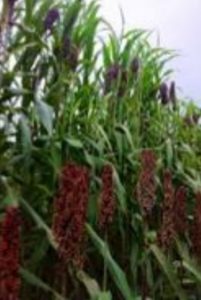The discovery of the gene behind stem juiciness in sweet sorghum could have huge agricultural implications
Sorghum, the fifth most popular crop worldwide, is used to create many products in the United States and is widely consumed by people in developing countries. The discovery of a crucial gene controlling stem juiciness in sorghum has important implications for the genetic improvement of this ancient grain and likely other crops as well.

Perhaps you’ve never tasted sorghum (Sorghum bicolor), the fifth most popular crop in the world, but you probably will soon. This ancient grain is a common source of food in developing countries and is also used to make Baijiu, one of the world’s most popular spirits. Grain sorghum, a tough, drought-tolerant plant with dry, brittle stems, is also used to make products ranging from animal feed to industrial chemicals to gluten-free flour, and it represents a promising source of biofuel. The less common juicy-stemmed sweet sorghum varieties are used to produce a maple syrup-like product. Stem juiciness can make a plant more tolerant of drought, but it can also make it less disease resistant, and the height of these plants can cause them to topple over in the wind. Understanding how the stem juiciness trait evolved and identifying the underlying gene could help breeders fine-tune this trait in sorghum and other important crops while shedding light on stem water transport in plants. Over 100 years ago, scientists discovered that stem juiciness is governed by a single genetic locus called Dry. While this genetic region has since been narrowed down to a small area on a single chromosome, moisture levels in sorghum stems can be quite variable, making it difficult to study this trait and pin down the underlying gene.
Through careful genetic analysis of a large, diverse panel of sorghum varieties, scientists at the Chinese Academy of Sciences discovered the gene controlling the stem juiciness trait in sorghum, as described in this month’s issue of The Plant Cell. The Dry gene product appears to function as a master switch that controls the expression of many genes that help determine the shape and composition of the plant cell wall. Mutations in the Dry gene in juicy-stemmed sorghum varieties lead to abnormal cell walls and even cell collapse, but the high sugar content in these plants enhances their growth and could lead to increased grain production. It appears that breeders have long been selecting plants with mutations in the Dry gene to increase the efficiency of sorghum syrup production. The authors identified similar genes in other crop species, providing the opportunity to shape the level of stem juiciness in other plants as well. According to Dr. Thomas Juenger of the University of Texas, “This is an important discovery of an iconic sorghum gene and a great example of an integrative approach using genetic mapping, natural variation, and transgenic manipulations to understand a key factor underlying an important domestication event”.
Author:
Tall and short sorghum
varieties growing in the field.
Jennifer Lockhart, PhD
jlockhart@aspb.org
Science Editor, The Plant Cell
http://orcid.org/0000-0002-1394-8947
Tel: 919-360-7699
Full citation: Li-Min Zhang, L.M. et al. (2018). Sweet Sorghum Originated through Selection of the Dry
Gene, Encoding a Plant-specific NAC Transcription Factor. Plant Cell doi: https://10.1105/tpc.18.00313.
http://www.plantcell.org/content/early/2018/09/25/tpc.18.00313.
About the researchers: To arrange an interview with Dr. Hai-Chun Jing of the Chinese Academy of
Sciences, please contact caihw@cau.edu.cn.
About The Plant Cell: Published monthly by ASPB, The Plant Cell (http://www.plantcell.org/) is the highest-ranking primary research journal in plant biology. The Plant Cell publishes novel research in plant biology, especially in the areas of cellular biology, molecular biology, genetics, development, and evolution. The primary criteria for publication are that the article provides new insight that is of broad interest to plant biologists, not only to specialists, and that the presentation of results is appropriate for a wide audience.
About ASPB: ASPB is a professional scientific society, headquartered in Rockville, Maryland, devoted to the advancement of the plant sciences worldwide. With a membership of almost 5000 plant scientists from throughout the United States and more than 50 other nations, the Society publishes two of the most widely cited plant science journals: The Plant Cell and Plant Physiology. For more information about ASPB, please visit http://www.aspb.org/. Also, follow ASPB on Facebook at Facebook.com/myASPB and on Twitter @ASPB.
Figure credit: Dr. Nadia Shakoor, Donald Danforth Plant Science Center.
Restrictions: Use for non-commercial, educational purposes is granted without written permission. Please include a citation and acknowledge ASPB as copyright holder. For all other uses, contact diane@aspb.org.
